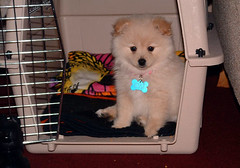Potty training a puppy takes patience and consistency. Crate training is best, but you can give them a little more space. It is very important to have a crate big enough to grow with your breed of dog. I also bought an "exercise fence", which is extra long and folds up. They can be purchased at most pet stores or online. Baby gates are also a good purchase. They don't have to be made specifically for dogs because they are really the same thing. I bought three baby gates at Meijer and they were a lot cheaper than buying a "doggie" gate. Once you have the crate and at least one baby gate, you are ready.
The first thing to do is confine your puppy to a small area with an easy to clean floor (which usually means the kitchen, bathroom or any room with a hard surface). The puppy should be kept confined to this area during the night, while you're at work or when you can't keep a watchful eye on them. I don't suggest leaving them in confinement more than needed, because you need to have positive interactions with your dog. They also need to be social at a young age to avoid aggressive behavior later. Make sure the crate has something soft to lay on (I use fluffy bathroom rugs), plenty of water and a favorite toy to play with. A bored dog is a destructive dog!
The next you need to do is get them on a schedule. Dogs love structure and need this more than anything. Always take the dog out as soon as you get up in the morning, after feedings, as soon as you get home from work and right before you go to bed. A puppy may need to go out every 30-60 minutes at first, just to get the hint.
Once you are outside, tell them to go potty, pee pee or whatever word you are planning to use for that. It needs to be the same word, all the time. Dogs do learn what words mean and mine can even spell. As soon as the pee or poop happens, shower your dog with tons of praise. Acting really excited, talking in a higher voice and jumping around like a "fool" can help them understand your excitement. Always say, "good pee pee" (or whatever word you're using) and I do mean EVERY time. Carrying around small treats certainly can add to their positive experience.
You must stick with a routine or you won't get the results you're looking for. I also don't suggest teaching them to pee on anything in the house. I trained my first dog to go in a "doggy litter box" that I kept a "pooch pad" in front of. The big problem was, when we moved, there was no longer a good spot for that. Since she was going out side like a normal dog, I didn't worry about having it out. Now, my throw rugs get used in emergencies because she thinks they're "pooch pads".
Never ever rub your dogs' nose in it. By the time you find the mistake, it is too late. Punishing them after the fact is confusing and they don't know why you're mad. You can only scold (use a deep and serious voice) them when they are being caught in the act.
Keep to the schedule and routine, then before you know it, they are fully trained. These tips can apply to any age dog.
Wednesday, March 25, 2009
Subscribe to:
Post Comments (Atom)






No comments:
Post a Comment